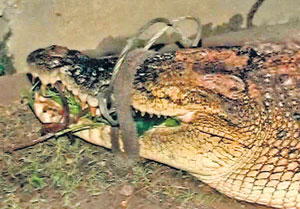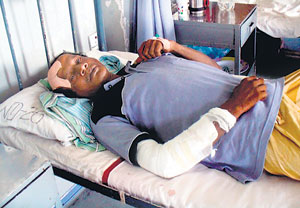Gamini and his friends were on their way home after their day’s work. A gentle breeze was blowing across the paddy fields adjoining Devala Road, Pannipitiya. Although the narrow footpath was in shadow, one of Gamini’s friends spotted something emerging from the canal. Driven by curiosity, they went to the edge of the canal and saw to their surprise a 10-foot crocodile.
In minutes, the entire village had arrived on the scene to see the “unexpected guest”.
There was an immediate debate on what to do next.
Some of the villagers wanted to call the police or wildlife officials, but most were in favour of keeping a watch on the crocodile and making sure it would not harm anyone. The villagers made a quick decision to capture the croc, without further delay.
 |
| The captured croc |
Armed with ropes, one group moved in to corner the creature, while others made sure the animal did not escape. The crocodile attempted to make an exit through the narrow waterway, but the villagers blocked its way with sticks and logs.
Finally, they succeeded in getting the ropes around the crocodile’s powerful body. Having secured the ropes tightly around the crocodile, Gamini and his friends then attempted to drag the animal away from the canal. They managed to advance a few feet, but the croc swung its head around and bit into the ropes. To everyone’s horror, one rope snapped in the croc’s powerful jaws, like a piece of string.
At this point, Gamini realised the situation called for some fast action. He grabbed the croc. The animal clamped its jaws on Gamini’s right hand. He felt its powerful teeth piercing his flesh, but he managed to pull his hand out of the animal’s mouth.
Finally, after a herculean struggle that lasted two hours, Gamini and his friends succeeded in subduing the crocodile and tying it up. It was then about 10 p.m. “I could feel its breath,” said Gamini, from his hospital bed in Kalubowila. “I thought it would rip off my arm, but I wasn’t afraid. My main concern was the safety of the villagers. This is a footpath used by everyone, including children. I was determined not to let the croc go.”
Gamini has nine deep cuts in his arm, caused by the croc’s teeth and a gash on his forehead. He will be spending the next few days in hospital, until he is fit enough to be discharged.
Gamini, 47, says he is proud of tackling a potentially dangerous problem.
 |
| Gamini in hospital |
The animal in question is a saltwater crocodile, the larger of the two crocodile species found in Sri Lanka. The Pannipitiya canal extends to Kottawa and is linked to the Diyawanna Oya. It is believed that the crocodile had come from the marshes in the Kotte or Muthurajawela areas.
Upali Padmasiri of the Department of Wildlife Conservation and a team of DWLC officials rushed to Pannipitiya to inspect the crocodile. The DWLC has decided to relocate the crocodile in Uda Walawe. Mr. Padmasiri advised against heroic attempts to grapple with crocodiles. He said that if a croc is spotted, the department should be informed and will send a team to do the needful.
The villagers of Pannipitiya say they had sighted a crocodile two months earlier and, following a report from Senaka Kalubowila, Vice-Chairman of the Maharagama Muncipal Council, wildlife officers searched the canal.
“Trying to catch a crocodile is dangerous,” Mr. Padmasiri said. “Such attempts can be harmful to both the animal and those trying to catch it.”
Mr. Padmasiri, who has been a warden in the Uda Walawe National Park for several years, has observed human-crocodile co-existence and is familiar with the sight of villagers bathing in crocodile-infested waters.
“Not all crocodiles are man-eaters,” says Dr. Anslem De Silva, a crocodile specialist.
He likens crocodiles to elephants. Just as there are a few rogue elephants in the wilderness that deliberately attack humans, there are a few notorious crocs that are known to attack humans.
The crocodile’s natural diet is fish. Dr. De Silva said the practice of dumping animal carcasses as garbage has resulted in some crocs getting a taste for animal flesh.
The experts’ advice
If you see a crocodile, call the Environment Ministry/DWLC hotline 1991 |


